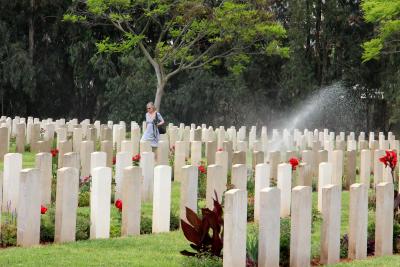The Commonwealth War Graves Commission was created by Royal Charter in May 1917 on the initiative of Sir Fabian Ware who recognised that there were more than a million war dead to be identified, buried, and commemorated worldwide, writes roving reporter Peter Martin.
The CWGC now has more than 2500 war graves with more than a million recorded burials in sites in more than 150 countries. Several of these sites are to be found in Israel and your correspondent recently visited cemeteries in Beersheba and Ramleh.
But why are there war graves in Israel at all?
The answer to this question lies in the history, principally WW1 history, of the campaigns in Palestine against the Ottomans. After the disaster of the Gallipoli campaign of 1916 the war cabinet in London needed a victory against the German supported and militarily well led and efficient Ottomans.
A Turkish incursion into the Sinai encouraged the British to use Palestine for a thrust into Damascus, Aleppo, and then Constantinople. The Ottoman attempt to take Suez failed but the extensive British and Commonwealth forces in Egypt were directed to attack Palestine using Gaza as a landing point – as had the Romans – and then moving up the coast.
Two attempts to take Gaza itself failed but a new general replacing the unsuccessful General Archibald Murray , Edmond Allenby, eventually succeeded in taking Gaza and Beersheba by military stratagems and tactics of great cunning, resourcefulness, audacity, and courage.
Very simply, over three nights of marches, the 3rd (Australian) Light Horse Brigade and New Zealanders of the New Zealand Mounted Rifles Brigade all under the command of General Harry Chauvel trooped Northwards to close off the Beersheba road against support from Ottoman cavalry.
The 4th (Australian) Light Horse Brigade and New Zealanders then charged onto the Ottoman trenches from the East, into the setting sun, overwhelming them and securing the vitally important Beersheba wells. Beersheba was then taken mostly at the point of the bayonet and there were relatively few Allied losses. Ottoman forces in Gaza were subsequently forced out by combined Australian and British forces.
Then, in deteriorating winter weather, wet and cold, Allenby’s forces moved up the coast taking Ramleh despite well led and well dug-in Ottoman resistance. The Allied forces suffered from internal dissensions and the loss of quality formations of troops to the Western front: they were hampered also by poor communications.
On Saturday 8th December 1917, Jerusalem was effectively taken by combined Australian, New Zealand, and British forces and the Ottomans, headquartered at the Augusta Victoria complex on Mount Scopus abandoned Jerusalem, heading North.
On Tuesday 11th December 1917 Allenby walked through the 380 year old Jaffa Gate and took over the Holy City on behalf of the Christian world, Allenby walking and not riding into the city as an act of homage and piety never forgotten locally.
Then followed the 1917 Balfour declaration, the Ottomans who had been terrorising Tel Aviv were duly expelled, and the Palestine British Emirate ( based in oil from Iraq) was established. Finally, after many more vicissitudes during the League of Nations Mandate, including an Arab uprising put down with much loss of life, the state of Israel was established in 1948.
There are Commonwealth War Graves in Gaza, Beersheba, Ramleh, and Jerusalem. All can be visited but Gaza not so easily during the current unrest.
During your correspondent’s May 2018 visit it was not possible to visit the Gaza cemetery as security could not be offered let alone guaranteed during the then current unrest and demonstrations but the Beersheba cemetery, most beautifully maintained despite drought and harsh weather conditions, is green and peaceful as it is persistently irrigated with recycled domestic water.
It contains some 1200 graves of Australian, New Zealand, and British dead from the 1917 campaign.
Ramleh is a much bigger cemetery than Beersheba. It contains the graves of 3300 Allied dead from WW1 and 1168 Allied dead from WW2. There are also the graves of 892 dead of other nationalities including German and Turkish and, in addition, dead from the Mandate years ending with the creation of the state of Israel in 1948. Again, most beautifully maintained and generously irrigated with extensive flower beds flourishing despite the extreme dryness of the soil and air.

